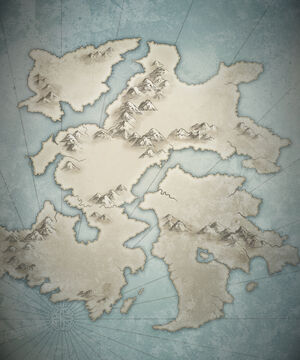
A geographical map of Zenith
Zenith (至天, Shiten) is the continent that serves as the main setting of Fire Emblem Heroes. It is home to the Askr Kingdom and the Emblian Empire, two nations vying for control of Zenith's portals to many other worlds.
Countries
Askr
The Askran Kingdom is ruled by a royal family with the power to open portals to other worlds. For many years, the Askran rulers worked along side the rulers of neighboring Embla to open and close portals and maintain peace across the worlds, but in recent times Embla has betrayed that tradition by refusing to close any portals. Prince Alfonse and Princess Sharena lead Askr in a desperate war to end Embla's conquests and return the universe to peace.
Embla
The Emblian Empire is ruled by a royal family with the power to close portals to other worlds. For many years, the Emblian rulers worked along side the rulers of neighboring Askr to open and close portals and maintain peace across the worlds, but in recent times Embla has betrayed that tradition by refusing to close any portals. The Emblians have invaded and conquered many worlds, binding their heroes to serve them in battle. Princess Veronica, Embla's ruler, desires to conquer all worlds and reign over the universe, but the lone Askr Kingdom stands in her way.
Nifl
The Nifl Kingdom is ruled by a royal family in a land surrounded by constant snow. In recent times, the neighboring Múspell overwhelmed and destroyed the kingdom, leading Princess Fjorm to joins forces with Askr and attempt to exact vengeance.
Múspell
The Múspell Kingdom is ruled by a royal family in a land surrounded by constant fire. In recent times, King Surtr has started a conquest to destroy other kingdoms, the latest being neighboring Nifl. Particularly setting his sights on Askr, it allies itself with Embla.
Hel
The Kingdom of Hel is ruled by Hel, the goddess of death, and her family, including Princess Eir.
Etymology
The word "zenith" derives from an inaccurate reading of the Arabic expression سمت الرأس (samt ar-ra's) proposed by ancient Persian astronomers, meaning "direction of the head" or "path above the head", by Medieval Latin scribes in the Middle Ages (during the 14th century), possibly through Old Spanish. It was reduced to 'samt' ("direction") and miswritten as 'senit'/'cenit', as the "m" was misread as an "ni". Through the Old French 'cenith', 'zenith' first appeared in the 17th century.

